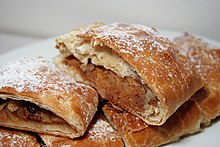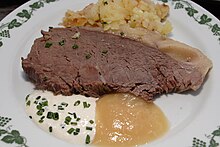Viennese cuisine

Viennese cuisine is the cuisine that is characteristic of Vienna, Austria, and a majority of its residents. Viennese cuisine is often treated as equivalent to Austrian cuisine, but while elements of Viennese cuisine have spread throughout Austria, other Austrian regions have their own unique variations. Viennese cuisine is best known for its pastries, but it includes a wide range of other unique dishes.
Vienna has been the capital of Austria for more than a thousand years. It became the cultural centre of the nation and developed its own regional cuisine; as such, Viennese cuisine bears the unique distinction of being the only kind of cooking named after a city.[dubious – discuss][1]
The variety of ingredients sold on the Naschmarkt might lead to the thought of a broadly varied cooking culture. In fact, dishes heavily depending on meat make up typical Viennese cuisine: Wiener schnitzel (veal coated in breadcrumbs and fried), Tafelspitz (boiled beef), Beuschel (a ragout containing veal lungs and heart), and Selchfleisch (smoked meat) with sauerkraut and dumplings are typical of its cooking.
Some sweet Viennese dishes include Apfelstrudel (strudel pastry filled with apples), Millirahmstrudel (milk-cream strudel), Kaiserschmarrn (shredded pancakes served with fruit compotes), and Sachertorte (cake of two layers of chocolate cake with apricot jam in the middle). These and many other desserts will be on offer at one of the many Konditorei of Vienna, where they are generally eaten with coffee in the afternoon.
Liptauer as a spread, or Powidl also as spread or base for dumplings are also quite popular.
History
The Viennese cooking tradition developed from many different sources. Italian influence has been strong since roughly the early 17th Century. In the 18th Century, French cuisine became influential in Vienna, along with French etiquette and diplomatic language. The term "Wiener Küche" (Viennese cuisine) first appeared in German language cookbooks around the end of the 18th century, and it was mistakenly treated as equivalent to Austrian cuisine. In the second half of the 19th Century, cookbooks started to include Bohemian, Hungarian (particularly with Gulaschsuppe, originally a Hungarian stew), Italian, Jewish, Polish and Southern Slavic features in Viennese cuisine. The croissant is also thought to have originated in Vienna after the defeat of the Turks in the Siege of Vienna.
Modern Viennese cuisine
In modern Vienna, many chefs have begun to combine traditional Viennese dishes with the principles of nouvelle cuisine to create what is known as "Neue Wiener Küche" (New Viennese cuisine). Also, Turkish, Jewish, Middle Eastern, and Indian cuisine have influence on the city because of growing immigrant communities.
Viennese dishes

Typical Viennese dishes include:
- Apfelstrudel (an apple-filled pastry)
- Topfenstrudel (a quark cheese-filled strudel)
- Palatschinken (Viennese crêpes)
- Powidl (from Czech povidla)
- Buchteln (from Czech buchty - yeast and butter baked good filled with Powidl or newly apricot jam)
- Wiener Schnitzel
- Sachertorte (a chocolate cake)
- Tafelspitz (boiled beef, often served with apple and horseradish sauces)
- Gulasch (a hotpot similar to Hungarian pörkölt - gulyás is a soup in Hungary)
- Selchfleisch (smoked meat) with Sauerkraut and dumplings.
- Rindsuppe (beef soup)
- Beuschel (a ragout containing veal lungs and heart)
- Liptauer cheese
- Germknödel
- Marillenknödel
The Danish pastry is said to originate from Vienna and in Denmark is called wienerbrød (Viennese bread), probably because it uses a certain kind of dough consisting of butter and flour in the classic cuisine referred to as "Viennese Dough". This pastry is called "Kolatsche" (from the Czech koláč) in Viennese.
See also
- Vienna bread, the unique and influential style of lighter bread with fresh leavening that developed in Vienna
- Viennoiserie, a French term referring to baked goods in the style of or influenced by Viennese baking
